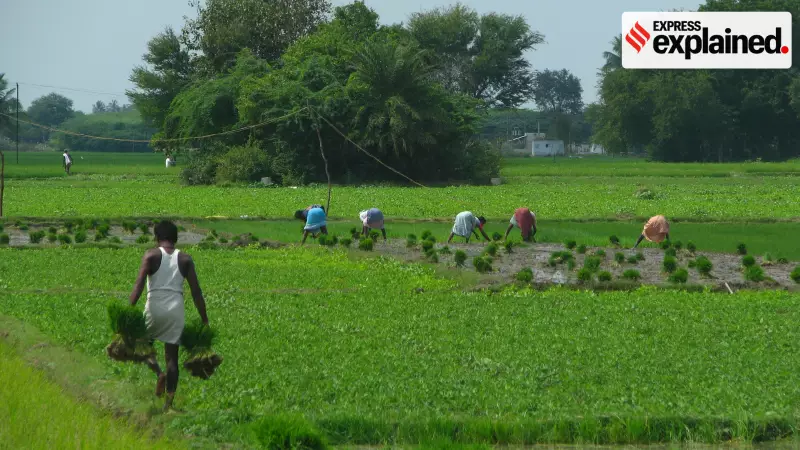
Tamil Nadu is grappling with an unprecedented procurement and storage crisis despite achieving its highest-ever paddy procurement of 47.99 lakh tonnes during the 2024-25 season. The record harvest, driven by abundant rainfall and expanded cultivation area, has created massive logistical challenges as the bumper crop coincided with the onset of the Northeast monsoon.
Unprecedented Harvest Meets Infrastructure Limitations
The crisis began with exceptional water availability in the Cauvery river system. From June 1, Tamil Nadu received approximately 161.6 tmc ft of Cauvery water at Biligundulu – significantly higher than its entitlement for that period. The Mettur dam maintained water storage above 90 tmc ft in August, providing Cauvery delta farmers with rare water security that encouraged expanded cultivation.
This water assurance translated into dramatically increased acreage. During the Kuruvai (short-term) season, the delta region normally covers around 4.4 lakh acres, but this year cultivation crossed 6.09 lakh acres by August 10 – representing a 40 percent increase over normal levels and 57 percent higher than the previous year's 3.88 lakh acres. Thanjavur and Tiruvarur districts alone accounted for nearly two lakh acres each.
The expanded cultivation directly fed into procurement numbers. By February 1, 2025, nearly 8 lakh tonnes of paddy had been procured statewide, with Cauvery delta districts contributing about 6.2 lakh tonnes. Thanjavur led with approximately 2 lakh tonnes, followed by Tiruvarur (1.6 lakh tonnes), Mayiladuthurai (85,400 tonnes), and Cuddalore (70,500 tonnes).
System Overwhelmed by Timing and Volume
The spectacular harvest numbers came with a critical complication – timing. Due to unusual rainfall patterns earlier in the year, many farmers shifted their cropping schedules or sowed later than usual. This resulted in Kuruvai harvests bunching up closer to the Northeast monsoon rather than completing well before its arrival.
By late September, Samba coverage in the delta was only about 1 lakh acres compared to 3.2 lakh acres the previous year, partly because Kuruvai fields were still being harvested. When the first heavy monsoon showers arrived, significant quantities of paddy remained either standing in fields or stacked near Direct Purchase Centres (DPCs).
The Tamil Nadu Civil Supplies Corporation (TNCSC) struggled with massive storage and transportation bottlenecks. Many DPCs, designed to hold about 3,000 bags, were crammed with 10,000 or more bags. The corporation faced difficulties moving stocks from DPCs to godowns and hulling mills due to limited storage capacity and transport constraints.
In response, district administrations implemented emergency measures. Thanjavur officials ramped up daily evacuation from about 2,000 tonnes to nearly 12,000 tonnes per day using rail, road and additional milling capacity. Nagapattinam district increased its DPC operations from just 23 last year to 124 centers this season.
Moisture Content Norms Spark Political Confrontation
The immediate flashpoint in the crisis revolves around Fair Average Quality (FAQ) norms, particularly the 17 percent cap on moisture content mandated by central government rules for procurement. Farmers argue that it's unrealistic to dry paddy down to 17 percent moisture during humid, rainy conditions, and any delays risk sprouting and heavier losses.
This situation prompted Chief Minister M K Stalin to write to Prime Minister Narendra Modi, requesting several crucial interventions. Stalin asked the Centre to relax moisture norms from 17 percent to 22 percent, increase the Union's Kharif procurement target for Tamil Nadu from 16 lakh tonnes to match actual output, and ease sampling norms for fortified rice kernels to accelerate hulling and stock movement.
The state government contends that inflexible FAQ standards, designed for north Indian kharif conditions, penalize Tamil Nadu farmers who harvest during monsoon season. Farmer groups have described the crisis as "entirely man-made," blaming both central government regulations and state planning failures.
Following the state's request, the Centre dispatched a team of senior officials to districts including Cuddalore to physically measure moisture levels and assess damage. Farmers informed the inspection team that continuous rain had pushed moisture levels well above established norms and requested official permission for procurement up to 22 percent moisture content to prevent financial ruin.
Structural Issues and Political Implications
Beyond immediate logistical challenges, agricultural experts point to deeper structural issues in Tamil Nadu's paddy ecosystem. Traditional, flood-resistant varieties in the older Cauvery delta have gradually been replaced by high-yielding hybrids and short-term varieties. These newer strains promise higher yields but often mature later and are less suited to local water and soil conditions, pushing harvests into the peak monsoon window.
On the procurement infrastructure front, TNCSC unions highlight chronic problems including overloaded godowns and CAP yards, shrinking open storage spaces, and shortages of field officers and loading staff. Farmer leaders have also alleged corruption and "proxy tenders" in transportation contracts, forcing small and marginal farmers to sell to middlemen who then use farmers' documents to sell to DPCs while skimming margins.
With an assembly election year approaching, the paddy crisis has acquired significant political momentum. Opposition leaders including former Union minister Anbumani Ramadoss have accused the state's Dravida Munnetra Kazhagam government of allowing Kuruvai paddy to "lie in the rain." Farmers' bodies linked to Left parties have demanded compensation of Rs 30,000 per acre for waterlogged fields that prevented harvest, plus specific relief for damaged Samba crops.
The DMK government has countered by highlighting the unprecedented scale of procurement achievements and the state's top-up over Minimum Support Price – Rs 130 per quintal for Grade A and Rs 105 for common varieties. Stalin's strategic communication to the Centre positions Tamil Nadu as a "record-producing" state constrained by Delhi's one-size-fits-all standards, addressing both concerned delta farmers and the broader electorate witnessing the paddy crisis unfold in real time.
Agricultural researchers note that while the immediate conflict revolves around moisture percentages and storage capacity, the underlying issue tests whether India's grain procurement system can adapt to changing climate patterns and shifting agricultural practices.





